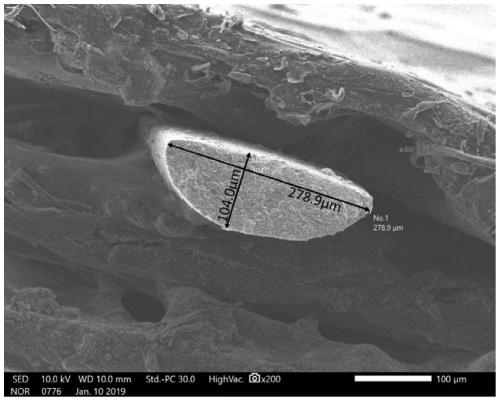Low over-cured calcium phosphate ceramic slurry for light curing molding and preparation method thereof
A technology of calcium phosphate ceramics and light-curing molding, which is applied in the direction of additive processing, etc., can solve the problems that hinder the application of ceramic 3D printing technology, cannot meet the field of bone implantation, and reduce the printing resolution, so as to ensure the vertical and horizontal resolution. , Scattering effect improvement, good vertical and horizontal resolution effect
- Summary
- Abstract
- Description
- Claims
- Application Information
AI Technical Summary
Problems solved by technology
Method used
Image
Examples
Embodiment 1
[0030] Prepare a high-energy planetary ball mill, add appropriate size zirconia balls, 14g of low-light curing monomer tricyclodecanyl dimethanol diacrylate and 6g of high refractive index light-curing monomer ethoxylate into the cleaned ball mill jar Hydroxylated bisphenol A di(meth)acrylate, 0.2g photoinitiator 2-hydroxy-2-methyl-phenylacetone-1, 0.8975g phosphate dispersant, 0.005g benzotriazole UV absorber agent, stir to mix and dissolve. Weigh 50g of β-tricalcium phosphate and 12g of biological glass powder in three times in a ball mill jar, each time weigh 15.95g of β-tricalcium phosphate and 4g of biological glass powder, and successively weigh them at 200r / min, 250r / min, 250 / min Each ball milled for 2 hours at a rotating speed of min. The desired slurry is obtained after ball milling. A single scanning line experiment (scanning speed 2m / s, power 450mw) shows that the curing depth and curing width of the slurry are respectively changed from the original 229.9μm and 47...
Embodiment 2
[0032] Prepare a high-energy planetary ball mill, and add an appropriate amount of zirconia balls, 14g of light-curing monomer 1,6-ethylene glycol diacrylate and 6g of high-refractive index light-curing monomer ethoxylated bisphenol into the ball mill jar A di(meth)acrylate, 0.2g photoinitiator 2-hydroxyl-2-methyl-p-hydroxyethyl ether base phenylacetone-1, 1.2g phosphoric ester dispersant, 0.0057g triazine UV absorber agent, stir to mix and dissolve. Weigh 48g of β-tricalcium phosphate and 12g of biological glass powder in three times in a ball mill jar, weigh 16g of β-tricalcium phosphate and 4g of biological glass powder each time, and successively weigh them at 200r / min, 200r / min, 250r / min Each ball milled for 1.5 hours at a rotating speed. After ball milling, a slurry that meets the requirements is obtained. A single scanning line experiment (scanning speed 2m / s, power 450mw) shows that the curing depth and curing width of the slurry are reduced to 147 μm and 263.5 μm (s...
Embodiment 3
[0034] Prepare a high-energy planetary ball mill, and add an appropriate amount of zirconia balls, 6g of photocurable monomer methoxypolyethylene glycol (350) monoacrylate and 14g of high refractive index photocurable monomer ethoxy Bisphenol A di(meth)acrylate, 0.2g photoinitiator 2-hydroxyl-2-methyl-phenylacetone-1, 1.05g polyacrylate, 0.0066g hindered amine UV absorber, stirring Let it mix to dissolve. Weigh 70 g of hydroxyapatite in three times into a ball mill jar, each time weigh 23.3 g of hydroxyapatite, and ball mill at 200 r / min, 250 r / min, and 250 r / min for 1 hour. After ball milling, a slurry that meets the requirements is obtained. A single scanning line experiment (scanning speed 2m / s, power 450mw) shows that the curing depth and curing width of the slurry are reduced to 202.9 μm and 66.3 μm (such as Figure 5 ), the degree of overcuring is greatly reduced.
PUM
 Login to View More
Login to View More Abstract
Description
Claims
Application Information
 Login to View More
Login to View More - R&D
- Intellectual Property
- Life Sciences
- Materials
- Tech Scout
- Unparalleled Data Quality
- Higher Quality Content
- 60% Fewer Hallucinations
Browse by: Latest US Patents, China's latest patents, Technical Efficacy Thesaurus, Application Domain, Technology Topic, Popular Technical Reports.
© 2025 PatSnap. All rights reserved.Legal|Privacy policy|Modern Slavery Act Transparency Statement|Sitemap|About US| Contact US: help@patsnap.com



